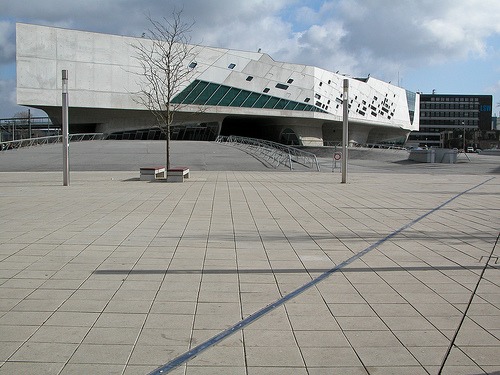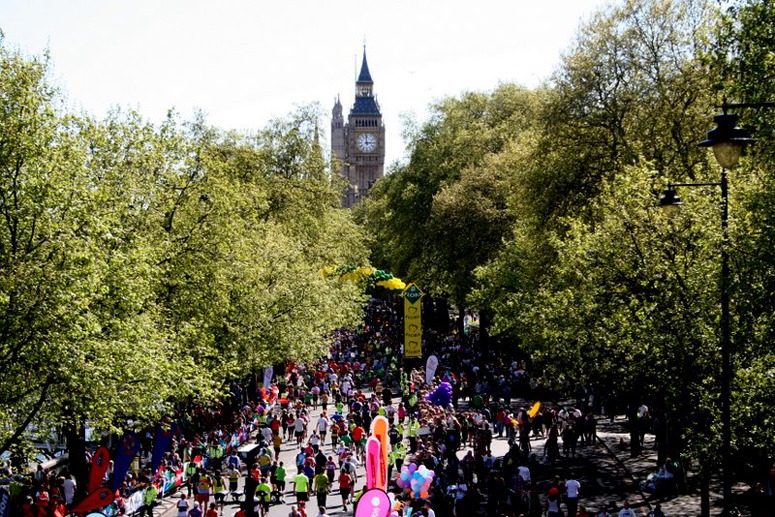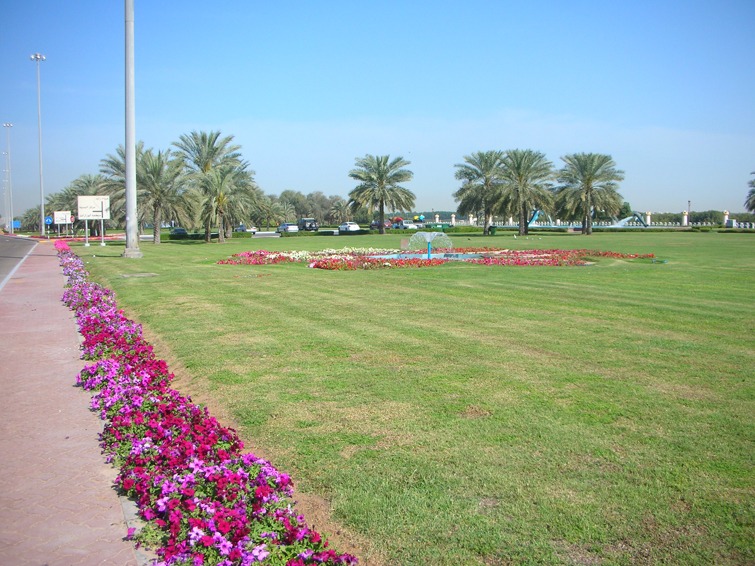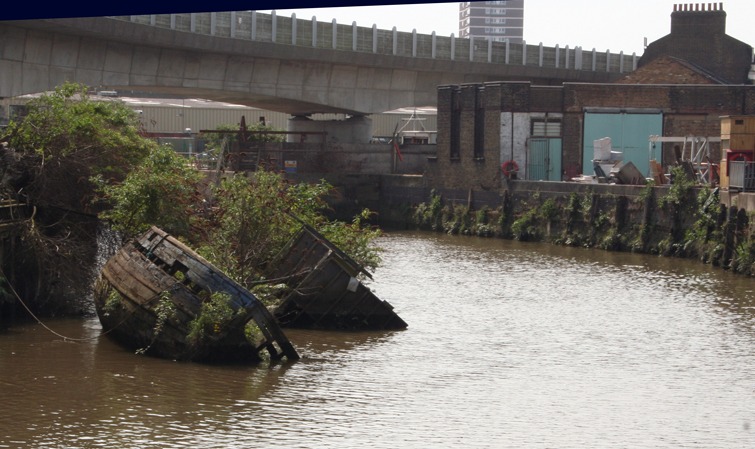 Zaha Hadid has a wonderful design sense – she could have been a sculptor. The BBC devoted a profile to her recently ( http://downloads.bbc.co.uk/podcasts/radio4/profile/profile_20090404-1900a.mp3 ) and in it Simon Jenkins remarks that ‘I don’t think she does context: she does concept’. He imagines all her buildings isolated in the Iraqi desert – like the Phaeno Science Center (photo courtesy maurizio mucciola) in Wolfsburg. It was a world-scale tragedy when, in 1893, the World’s Columbian Exposition turned the course of American architecture away from Sullivan and Wright and back to Italianism followed by European Modernism. The BBC also broadcast an excellent profile of Frank Lloyd Wright on 9th April 2009 http://www.bbc.co.uk/iplayer/console/b00jjjpv. He drew on the classic inspiration of landscape architecture: NATURE.
Zaha Hadid has a wonderful design sense – she could have been a sculptor. The BBC devoted a profile to her recently ( http://downloads.bbc.co.uk/podcasts/radio4/profile/profile_20090404-1900a.mp3 ) and in it Simon Jenkins remarks that ‘I don’t think she does context: she does concept’. He imagines all her buildings isolated in the Iraqi desert – like the Phaeno Science Center (photo courtesy maurizio mucciola) in Wolfsburg. It was a world-scale tragedy when, in 1893, the World’s Columbian Exposition turned the course of American architecture away from Sullivan and Wright and back to Italianism followed by European Modernism. The BBC also broadcast an excellent profile of Frank Lloyd Wright on 9th April 2009 http://www.bbc.co.uk/iplayer/console/b00jjjpv. He drew on the classic inspiration of landscape architecture: NATURE.
Author Archives: Tom Turner
Processional routes in urban and garden design
 Cities need good routes for processions and should ask garden designers to help with them, because garden design has so often been the crucible for urban design. The magnificent route in this photograph is shown on 26th April 2009 being used for the London Marathon. The route is on the north bank of the River Thames, with Big Ben in the background, and is one of the most comprehensive urban design projects London has ever seen. Most days of the year the place is made wretched by heavy traffic. But when closed for processions it is a wonder – which should be made permanent because, as Jane Jacobs remarked, urban designers should plan for the attrition of automobiles by cities. The land shown in the photograph was ‘reclaimed’ (ie stolen) from private gardens and from the River Thames. The project was designed by an engineer, Sir Joseph Bazalgette, and begun in 1862. It includes a low level interceptor sewer, an underground railway, a wide road and a retaining wall built with Cornish granite.
Cities need good routes for processions and should ask garden designers to help with them, because garden design has so often been the crucible for urban design. The magnificent route in this photograph is shown on 26th April 2009 being used for the London Marathon. The route is on the north bank of the River Thames, with Big Ben in the background, and is one of the most comprehensive urban design projects London has ever seen. Most days of the year the place is made wretched by heavy traffic. But when closed for processions it is a wonder – which should be made permanent because, as Jane Jacobs remarked, urban designers should plan for the attrition of automobiles by cities. The land shown in the photograph was ‘reclaimed’ (ie stolen) from private gardens and from the River Thames. The project was designed by an engineer, Sir Joseph Bazalgette, and begun in 1862. It includes a low level interceptor sewer, an underground railway, a wide road and a retaining wall built with Cornish granite.
Wiki has the following definition: ‘A procession (via Middle English processioun, French procession, derived from Latin, processio, itself from procedere, to go forth, advance, proceed) is, in general, an organized body of people advancing in a formal or ceremonial manner.’
Deptford Creek London Landscape Archaeology
I wish I could tell you whether this rotting barge is a ‘wreck awaiting removal’ or a ‘scheduled monument awaiting a viewing fee’. I fear the former. Deptford Creek is a very interesting place. Henry VIII established England’s first Royal Dockyard here. Peter Romanov, son of Alexis I, was born in the Kremlin and came to Deptford in 1698 to learn shipbuilding. This was 4 years before he became the Czar who became Peter the Great. An exceedingly strong man, he worked, drank and womanized with the shipwrights. From 1871 until 1914 Deptford was the City Corporation’s Foreign Cattle Market. But almost all the evidence of this fascinating history has gone. The Docklands Light Railway was as heartlessly perched over the river as if it been in Tokyo. Then, with the 1990s YBA’s and Britart, Deptford became an artist’s enclave. Most certainly, the old ships should not be removed. But nor should they be restored. They should be allowed to sink, ever so gradually, into the mud.
Eyesorit: I love lawns
My definition of an eyesorit is ‘an urban design which makes the eyes sore but tinged with mirth’, rather as Private Eye Magazine does with its brilliant covers. Normally, they are photographs with bubble captions.
The architect, the town planner, the highway engineer and the landscape architect responsible for this codge-up, photographed in London’s Isle of Dogs on 19.4.2009 should only venture out wearing shame-guards. It is a stupid waste of some of the world’s prime urban land. The road and the paths are ugly and too wide. The gardens and the balconies are too small. The lawn is but an exercise ground for lawn mowers. The greenspace has no use and no beauty. Its maintenance wastes fossil fuels. And yet this example is much better than many of the residential blocks the city has shoved up in the past decade, making London what Rasmussen might have called a ‘less-unique city’. It makes one wonder if professional bodies are worth having – and reminds one of Adam Smith’s remark that: “People of the same trade seldom meet together, even for merriment and diversion, but the conversation ends in a conspiracy against the public, or in some contrivance to raise prices.”
Abu Dhabi and sustainable landscape architecture in the Gulf
 Since Gulf and Asian landscape architecture are improving, it may be a good time to dwell on past mistakes. The above photo is of the east corniche in Abu Dhabi. It was designed in conjunction with major traffic routes and exemplifies what goes wrong when landscape architecture work is supervised by firms of engineering consultants. The east corniche ‘park’ lies beside a 12 lane carriageway and flyover. It is a horrible place to be, especially during the rushhour. Pedestrian access just about impossible. Abu Dhabi is not short of money but this is a terrible way to waste water, space and resources. The ‘park’, better described as a ‘GARK‘, is ‘decorated’ with petunias, lawns and a fountain. Abu Dhabi is developing a grey water mains water supply but many lawns of this type are watered with drinking water. Grassland irrigation is calculated at 12 litres per square meter per day, which is 4,380 litres of water per square metre per year. Since there are about 58,000 sq m of grass, it must require about 250 million litres of water per year. In desert conditions, petunias probably require more water. Desalination plants dump their excess salt back into the Gulf. This will turn the mangroves yellow in perhaps 50 years. Beyond the gark, to the right, you can see the tops of the mangrove swamps which border the Abu Dhabi Gulf coast. The mangroves grow practically without maintenance in seawater. They are an ecological treasure chest and very beautiful. One wonders if the ‘designer’ of the Corniche east park ever woke up and felt really stupid about what he or she had done. It is not too late to commission a landscape architecture firm to claim the gark for the mangroves.
Since Gulf and Asian landscape architecture are improving, it may be a good time to dwell on past mistakes. The above photo is of the east corniche in Abu Dhabi. It was designed in conjunction with major traffic routes and exemplifies what goes wrong when landscape architecture work is supervised by firms of engineering consultants. The east corniche ‘park’ lies beside a 12 lane carriageway and flyover. It is a horrible place to be, especially during the rushhour. Pedestrian access just about impossible. Abu Dhabi is not short of money but this is a terrible way to waste water, space and resources. The ‘park’, better described as a ‘GARK‘, is ‘decorated’ with petunias, lawns and a fountain. Abu Dhabi is developing a grey water mains water supply but many lawns of this type are watered with drinking water. Grassland irrigation is calculated at 12 litres per square meter per day, which is 4,380 litres of water per square metre per year. Since there are about 58,000 sq m of grass, it must require about 250 million litres of water per year. In desert conditions, petunias probably require more water. Desalination plants dump their excess salt back into the Gulf. This will turn the mangroves yellow in perhaps 50 years. Beyond the gark, to the right, you can see the tops of the mangrove swamps which border the Abu Dhabi Gulf coast. The mangroves grow practically without maintenance in seawater. They are an ecological treasure chest and very beautiful. One wonders if the ‘designer’ of the Corniche east park ever woke up and felt really stupid about what he or she had done. It is not too late to commission a landscape architecture firm to claim the gark for the mangroves.
Landscape and garden interpretation
Is this how we understand landscapes and gardens, natural and designed: through a friend’s camera reflected in our own glasses?
Image courtesy Mark Hodges.

